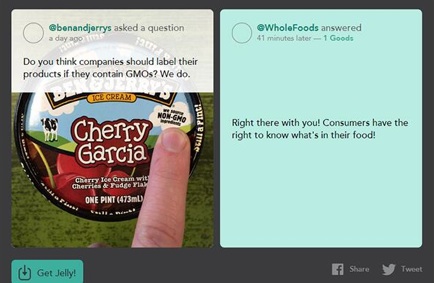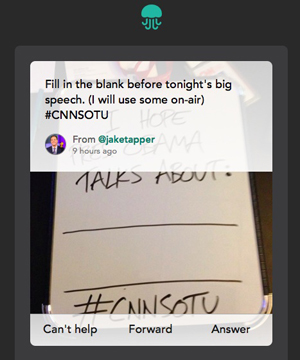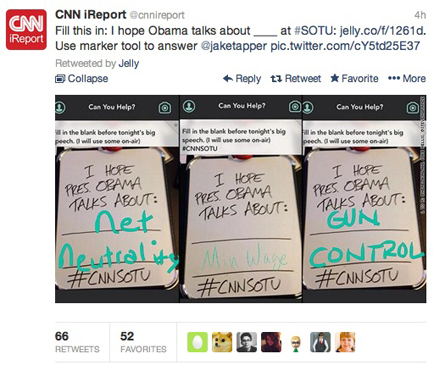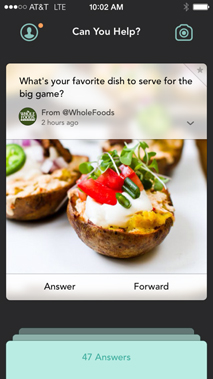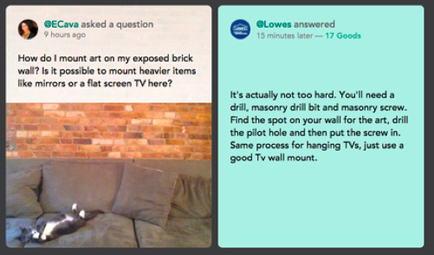Brands
Are Brands Ready for Jelly?
It’s been less than a month since the launch of Jelly, the new mobile app that’s part search engine, part social site. By now, most of us have an inkling of how it works — snap a pic with your mobile device, type in a related question, and send it out to be answered by your Jelly-enabled nexus of Twitter and Facebook connections.
Because the app was co-founded by Biz Stone, co-founder of Twitter, and has been funded by angel investors like Bono and Al Gore, it also comes with serious media caché.
What ultimately separates Jelly from visual networks like Instagram and Pinterest is a commitment to altruism. “People will be eager to help each other on Jelly because we are driven to help. That long term idea about making the world a more empatheticplace is something that really drives us,” said Stone in the app’s intro video.
One key question still remains about Stone’s dream for Jelly, even with support from an all-star team of investors: Can brands take advantage of the platform?
Content that cares
This emphasis on social good is something brands can get behind, and many began experimenting as soon as Jelly launched. Ben & Jerry’s, for example, surveyed customers about product packaging (“Do you think companies should label their products if they contain GMOs? We do.”).
This strategy helps gauge the consumer mindset, but more importantly, it underscores a core tenet of Ben & Jerry’s mission statement: to incorporate “wholesome, natural ingredients” into its products. In this regard, Jelly represents a new channel capable of showcasing the values paramount to any brand. It wouldn’t be surprising to see Chipotle or Whole Foods implement a similar strategy in the near future.
CNN is also finding its footing with Jelly. Prior to President Barack Obama’s State of the Union on January 28, CNN Anchor and Chief Washington Correspondent Jake Tapper used Jelly to poll users on what issues they wanted the President to address. Posts consisted of photographs of white boards that read, “I hope Pres. Obama talks about,” and asking users to fill in the blanks with text.
To extend the effort, CNN ran photos of the posts on CNN iReport, the news outlet’s consumer-centric Twitter feed. This time, the images were already completed by Jelly users, their answers supplied with the help of Jelly’s drawing tool. Because of its interactivity, the campaign demonstrated CNN’s commitment to tailoring content to its audience’s point of view.
Give and Take
With its Q&A format, Jelly can facilitate interaction with customers. But should brands be asking the questions or providing the answers? Whole Foods tends to do the asking, typically focusing on its products.
Just days after Jelly launched, home improvement retailer Lowe’s — already a trendsetter on Vine — posted a helpful answer to a question about hanging art on an exposed brick wall. “Our approach on Jelly is similar to our other social platforms –- provide value,” says Brad Walters, Director of Social Media and Emerging Platforms for Lowe’s. “We’ve found that there is benefit in both answering questions as well as asking users. But we tip our scales more toward answering questions because we feel we can provide more value to the customer as the industry expert.”
In addition to providing value, this game plan may also make for a more organic exchange. “My preference would be to see consumers lead the online conversation,” says Joseph Barbieri, Managing Director, Content & Media Partnerships at global agency Sid Lee. “That ensures authenticity to the dialogue and allows brands to engage in a more meaningful way.”
Too Soon?
More than a dozen brands have already joined Jelly, including Airbnb, CNBC, General Electric, and UK supermarket chain Asda. Experts wonder, however, if both Jelly and marketers might be moving too fast. “Jelly came out of the gate encouraging marketers to use the platform,” says Rebecca Lieb, analyst with Altimeter Group. “I think people are saying, make me love and need you before you push the ads at me. ”
According to Lieb, the typical strategy for a new social site is to rapidly increase its user based while making the platform indispensable to its target audience. Encourage brands to swarm through the city gates too soon, and you risk consumer backlash.
“There are people who can’t live without Twitter and Facebook, and one of the reasons is that they were pretty commercial message-free for years into the initial phases of their development. If there’s a golden egg here,” she says of Jelly, “I’m worried about killing the goose.”
“The challenge with innovation in technology is the tendency to gravitate to the ‘shiny new toy’ before it has been proven,” Barbieri added. “Consumer adoption will decide if it has legitimacy as a new social tool. It needs an incubation period to allow that adoption to take hold so that in the long term marketers can benefit in a meaningful way.”
Walters agrees it’s wise to be prudent. “Social marketers within brands have an obligation to embrace new social platforms somewhat cautiously. It absolutely makes sense to experiment on the platform, but we should do so sparingly and thoughtfully.”
Content marketers will continue to explore marketing opportunities Jelly has to offer. For now, they’ve yet to get stung. But whether Jelly’s popularity continues to surge is still a giant question. And no picture can help answer that.
Image by Cody
Get better at your job right now.
Read our monthly newsletter to master content marketing. It’s made for marketers, creators, and everyone in between.
